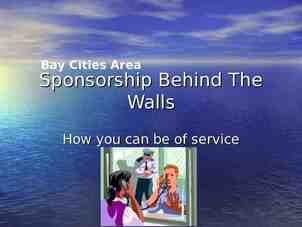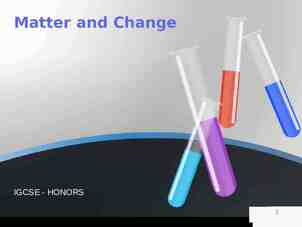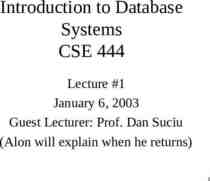MGT 674 Employee Relations Management Ajaya Mishra
35 Slides975.00 KB
MGT 674 Employee Relations Management Ajaya Mishra
About Faculty Professional Experiences: 5 years in banking (MBL and Prudential) 6 years in media (NTV and ATV) 5 years in INGOs (UNDP/PLAN International) 5 Years in Government (MOE / CTEVT) Academics M. Phil. in Management (Leadership) MBA (E) in Human Resource Management Leadership Program (ISB, Hyderabad) International Board and Management Program
Research and Publications M. Phil. Thesis on “Understanding of Leadership and Factors Associate with Leadership Success, Nepalese Perspective”. Research paper presented in South Asian Management Forum on “Leadership Styles and Employees’ Commitment to Organizational Change on Organizational Performance: A Study in a Nepali Technology Based Organization”. Training Manual for Institutionalisation of Project Activities, Cooperative Management, Micro Credit and Enterprise Development. Research Papers on Media industry, human resource development practices in public service organizations, etc.
Employee Relations Overview
What is Employee Relations? Employee relations refers to the interrelationships, both formal and informal between managers and those whom they manage. How are we managed? how we would like to be managed? how and why conflicts arise? and how these can be resolved at work? These are the basic concern of employee relations.
Traditional and newer concerns Traditional focus on ‘actors’ like managers, employees, government, unions. Until recently looked at person, unions, manufacturing, manual work. Today, increasing interest in ‘new’ actors – customers, families, other interest groups - and in service sector, women and complexity of employment arrangements. Widening focus has broadened scope of employee relations concerns
Why are Employee Relations worth studying? For many people work is central in terms of time, money, identity, status, social relations Most of us experience work as employees – we have an employment relationship – between ourselves and those who employ us, and an employment status However many different interests at work (‘stakeholders’) – owners, shareholders, managers, employees, customers – all exert pressure on employment relationship
For employers – the ‘labour question’ a central one Need labour to produce output Need to ensure labour does what employers want Need for control – of labour costs and activities - and need for welfare Tension – control v commitment
The Employment Relationship It follows that the ‘employment relationship’ is a central feature of work but it is dynamic. It is also complex – has many dimensions and levels – economic, legal, social, psychological and political Shaped by historical experiences Employment relationship now seen as core to the study of employee relations Many employment relationships, many employee relations
The Employment Relationship Parties to Relationship Operation Level Substance Employment Relationship Process Style Structure Individual: reward, job, career Collective: joint agreements Formal rules Informal understandings Source: Kessler and Undy 1997
The Course and Evaluation 12 Sessions direct contact on Tuesday. Focus on case study analysis and presentation, Group discussion and Group work. Evaluation Criteria Class Participation and Attendance Case Analysis and Presentation Group Work (Brief Research work) Mid Term Exam Final Exam 10% 15% 20% 15% 40% Case analysis, group work and assignments should be submitted on time. Absent during case presentation will be graded “F” in internal evaluation.
Article Critiquing Framework Issues the author is trying to address The Significance of the study or issue Basic Assumptions Theoretical Framework / Concepts Methodology used Contribution of the study Practical and managerial implication of study Conclusion of the study
Group Work Method: Qualitative Framework: Understanding of Employee relations practices Importance given to employee relations Strategies adopted Existence of union and their role Collecting bargaining and grievances handling practices. Employee’s perspective Vs Organizational perspective Impact on Organizational performance and employee satisfaction Others specific, if any.
Employee Relations
Employee Relations: Content, History, Analysis Industrial Relations, Employee Relations and Employment Relations IR traditionally concerned with ‘the institutions of job regulation’ (Flanders and Clegg 1954) and the generation of employment rules Led to a focus on trade unions and collective bargaining – CB ‘pivot’ of industrial relations ‘High point of traditional IR’ in Britain 1970s – collectivist, concern with reform of collective bargaining – 55% of the workforce were trade union members, 75% covered by collective agreements
Historical Perspectives Event-driven Structure-driven Government change Technological change Economic trends Political trends Demographic change Management change Changes to social institutions Changes in ownership and organisation Unique events and conditions - linear Regular, patterned, repetitive - circular
Historical Perspectives In practice history reveals patterns of both change and continuity Change may be abrupt but may still be affected by path- dependency Short-term and long-term change Significance in employee relations for how history is experienced, how it shapes the present – often casts a long shadow History in culture – stories, rituals, rules Employee relations today the outcome of past struggles – defeats, victories Importance of history in custom & practice
Traditional Concerns of IR Theoretical origins of industrial relations/employee relations focused on order and stability within a developed ‘system’ Influence of US writers, particularly Dunlop (1958) Such a ‘system’ in Britain and other western economies based on collective bargaining – seen as democratic and most effective form of regulation Copied by many other countries Outputs of the system – earnings, productivity and minimising of conflict
Industrial Relations IR is concerned with the systems, rules and procedures used by unions and employers to determine the reward for effort and other conditions of employment, to protect the interests of the employed and their employers and to regulate the way in which employers treat their employees. K. Aswathappa
Coverage of IR Collective bargaining Role of management, unions, government Machinery for resolution of industrial disputes Individual grievances and disciplinary policies and practices. Labor legislation Industrial relations training.
John Dunlop and an Industrial Relations System CONTEXTS ACTORS PROCESSES Economic Employers Managerial Reg Pay and Social Managers Collective Conditions Legal Trade Unions Bargaining Inc Productivity Political Employees Legal Reg. Conflict Techno – Customers* C&P Less Conflict Logical Shareholders* Feedback Shared Ideology OUTCOMES
IR to ER Employee relations is more comprehensive and includes all aspects of HRM where employees are dealt with collectively. It covers Participative management Employee welfare Employee development Employee remuneration, safety, welfare, etc.
Challenges to the ‘system’ - crisis and re-regulation Post 1979 ‘Thatcherism’ Public policy – lack of support for old ‘adversarial’ IR system, trade unions, failure of collective bargaining Moves to regulate IR through legal means – restrictive labour law to ‘curb the power of trade unions Re-establishment of managerial prerogative Re-regulation of industrial relations against a backdrop of high unemployment and weakened TU bargaining power
Is talk of a system still useful? Can we still talk about ‘national systems’? Often more diversity within as between countries (Marchington 1995) Argued that if we can still talk about a ‘system’ it is now organisation-based Purcell (1989) Greater diversity in employee relations as managers have sought to re-regulate employment and employment relationships
Changing Focus – Managerial agenda Today management-employee relations in Britain more about involvement, engagement, participation and partnership rather than collective bargaining and conflict resolution Employee involvement and high performance work systems, employee engagement. The role of management choice in shaping employee relations and employee relations strategy
Employment Relations and HRM HRM and the ‘individualisation’ of employment relations Focus on the individual worker and relationship with management Mainstream HRM – concern with involvement and commitment and relationship to business performance (Guest et al. 2000) Business-model of HR dominant
And Now . Increased concern with both individual and collective aspects of employment Re-focusing on how the employment relationship is regulated. Theoretically, this marks a return to a focus on power and authority relations in employment
Main Parties Engaged in ER Individual Employees Trade Union Representative Government Managers Employer – Employee Relations Employer’s Association Representative Courts and tribunes
Different Perspectives of Employee Relations
Manager’s perspective Creating and maintaining employee motivation Obtaining commitment from the workforce Establishing mutually beneficial channels of communication Achieving high level of efficiency
Negotiating terms and conditions of employment Sharing decision making with employees Engaging in power struggle with trade unions
Trade union’s perspective Collective bargaining about terms and conditions of employment Representing individuals in conflict with management Improving abilities of employees to influence events in the workplace Regulating relations with trade unions.
Individual employee’s perspective Improve their conditions of employment Voice and grievances Exchange views and ideas of management Share in decision making
Third Parties' perspective Creating and maintaining harmony at work Creating a framework of rules for fair conduct in relationships Establishing a peace making arrangements Achieving a prosperous society with justice
?








































